1 of 19
Downloaded 14 times






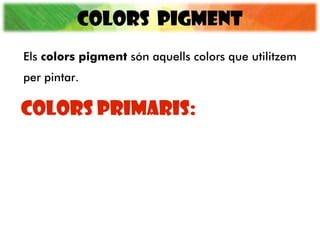
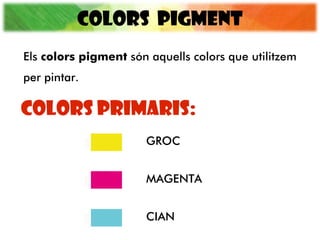
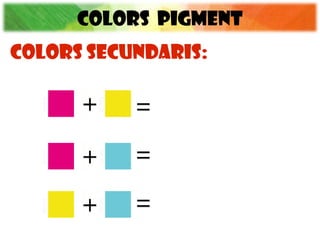

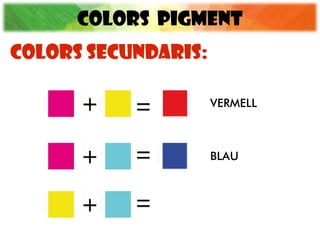
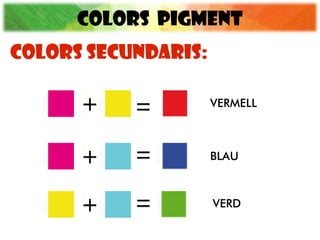
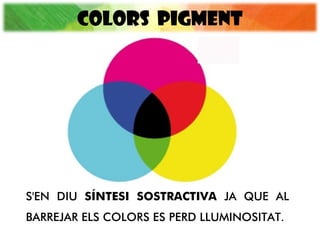
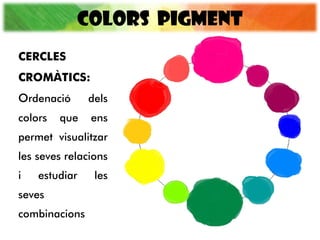
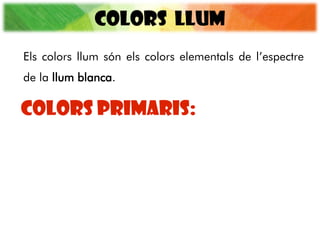
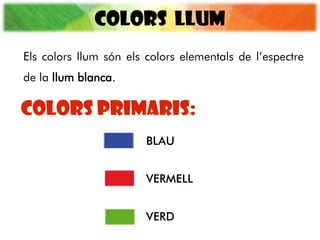

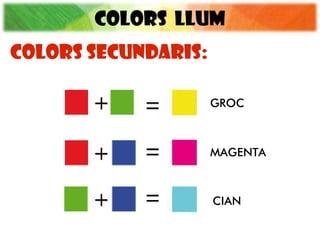
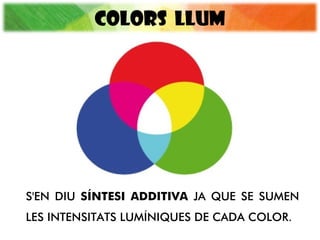
Ad
Recommended
Els elements del llenguatge visual i pl├Āstic
Els elements del llenguatge visual i pl├Āsticvalletejedor
╠²
EL PUNT, LA LINIA, EL PLA I LES TEXTURES.Paraules d'octubreLaia Lila
╠²
El documento lista palabras en catal├Īn asociadas con el mes de octubre, incluyendo tardor (oto├▒o), fulles (hojas), pluja (lluvia), paraig├╝es (paraguas), cistella (cesta), taronja (naranja), magrana (granada), ra├»m (uva), carbassa (calabaza), bolet (seta), guix (tiza), esquirol (ardilla), cargol (caracol), ovelles (ovejas) y eri├¦├│ (erizo).Els mitjans de transport
Els mitjans de transportMonica Roige Sedo
╠²
power point per explicar els mitjans de transport i les seves diferents classificacions
Aquests materials es poden veure i descarregar a la WEB: https://sites.google.com/site/activitatsperprimerdeprimaria/medi/medi-social
Tamb├® hi ha fitxes de comprensi├│ lectora del tema.Elements visuals punt linia pla forma textura
Elements visuals punt linia pla forma texturasandroalfaro
╠²
Morfologia de la imatge. Elememts b├Āsics FITXA D'UN ANIMAL.3r 2013-2014
FITXA D'UN ANIMAL.3r 2013-2014Mar Gomez Cortes
╠²
Hem fet una fitxa d'un animal, per parelles a l'aula d'inform├Ātica. L'animal l'han triat els nens. Classificaci├│ dels animals vertebrats
Classificaci├│ dels animals vertebratsNeus Vi├▒allonga
╠²
Presentaci├│ editada den Cristina Vall├©s sobre la classificaci├│ dels animals vertebrats.El doble (fitxa)
El doble (fitxa)VIOLETA CRISTI├Ć
╠²
Fitxa per treball el concepte "doble" amb alumnes de cicle inicial. consta de dues p├Āgines. Els determinantsmjosePardo2
╠²
Este documento proporciona una explicaci├│n detallada de los diferentes tipos de determinantes en catal├Īn, incluyendo art├Łculos, posesivos, demostrativos, numerales, cuantitativos, indefinidos, interrogativos y exclamativos. Describe las funciones de cada tipo de determinante y c├│mo concuerdan con el sustantivo al que acompa├▒an en g├®nero y n├║mero.Presentacio projecte espai
Presentacio projecte espaijbigas
╠²
Projecte sobre l'espai fet per nens de cicle inicial. Escola Pompeu Fabra. ManlleuMore Related Content
What's hot (20)
Elements visuals punt linia pla forma textura
Elements visuals punt linia pla forma texturasandroalfaro
╠²
Morfologia de la imatge. Elememts b├Āsics FITXA D'UN ANIMAL.3r 2013-2014
FITXA D'UN ANIMAL.3r 2013-2014Mar Gomez Cortes
╠²
Hem fet una fitxa d'un animal, per parelles a l'aula d'inform├Ātica. L'animal l'han triat els nens. Classificaci├│ dels animals vertebrats
Classificaci├│ dels animals vertebratsNeus Vi├▒allonga
╠²
Presentaci├│ editada den Cristina Vall├©s sobre la classificaci├│ dels animals vertebrats.El doble (fitxa)
El doble (fitxa)VIOLETA CRISTI├Ć
╠²
Fitxa per treball el concepte "doble" amb alumnes de cicle inicial. consta de dues p├Āgines. Els determinantsmjosePardo2
╠²
Este documento proporciona una explicaci├│n detallada de los diferentes tipos de determinantes en catal├Īn, incluyendo art├Łculos, posesivos, demostrativos, numerales, cuantitativos, indefinidos, interrogativos y exclamativos. Describe las funciones de cada tipo de determinante y c├│mo concuerdan con el sustantivo al que acompa├▒an en g├®nero y n├║mero.Presentacio projecte espai
Presentacio projecte espaijbigas
╠²
Projecte sobre l'espai fet per nens de cicle inicial. Escola Pompeu Fabra. ManlleuViewers also liked (20)
Per saber m├®s sobre els colors
Per saber m├®s sobre els colorsalbacirera
╠²
Complement del primer power sobre els colors que vaig publicar.Els Colors
Els Colorsalbacirera
╠²
Treball realitzat per Alba Cirera i Ainoa Rius de l'institut IES Baix Pened├©s en el que es presenta de manera simple i breu la teor├Ła dels colors.El colorConchi Bobadilla
╠²
El documento describe la naturaleza del color, incluyendo que es una sensaci├│n perceptiva que tiene lugar en el cerebro y que involucra la luz, los materiales y el ojo. Explica la luz visible, la absorci├│n y reflexi├│n de la luz por los objetos, y c├│mo el ojo humano percibe los colores a trav├®s de los conos y bastones en la retina. Tambi├®n resume los sistemas crom├Īticos como forma de codificar y organizar los colores, y los conceptos de armon├Ła y contraste crom├Ītico en la composici├│n art├Łstica.El colorCres68
╠²
El documento habla sobre el color. Explica que el color es una sensaci├│n producida en el cerebro que involucra la luz, su reflexi├│n en superficies y la visi├│n. Describe los colores primarios de la s├Łntesis aditiva y sustractiva y c├│mo se pueden obtener colores secundarios y terciarios. Tambi├®n cubre conceptos como el c├Łrculo crom├Ītico, los contrastes, afinidades y armon├Łas de color.El colorEva Avila
╠²
El documento aborda la historia y caracter├Łsticas del color, incluyendo su definici├│n como producto de longitudes de onda y su percepci├│n visual. Examina la teor├Ła del color a trav├®s de diversos fil├│sofos y cient├Łficos, desde la antig├╝edad hasta la actualidad, y su impacto en la psicolog├Ła y el simbolismo. Adem├Īs, se discuten las cualidades del color, como el tono, la saturaci├│n y el valor, as├Ł como su aplicaci├│n en el arte y la publicidad.Ad
Similar to Els colors (20)
Teoria del Color
Teoria del Colorjoanprofedarts
╠²
Teoria del color:
Factors que intervenen (f├Łsica del color)
Propietats
Harmonies crom├ĀtiquesFonaments del color
Fonaments del color├Ćngels Mart├Łnez Badia
╠²
Teoria del color i la seva aplicaci├│ a la pintura.
Educaci├│ Visual i pl├Āstica E.S.O.
Introducci├│ al color
Introducci├│ al colorBel M├│n Art
╠²
Introducci├│ al color i la teoria de Newton sobre la llum i la visi├│Ad
More from pacrucru (20)
Elements PUNT I LINIApacrucru
╠²
Este documento describe los elementos visuales b├Īsicos de una imagen: el punto, la l├Łnea, el plano y las texturas. Explica que el punto es el elemento m├Īs peque├▒o que se puede dibujar y que genera sensaciones visuales como equilibrio, inestabilidad y movimiento. Luego describe c├│mo un punto en movimiento se convierte en una l├Łnea, y c├│mo las l├Łneas configuran formas y organizan las im├Īgenes a trav├®s de las l├Łneas de tensi├│n. Finalmente, incluye algunos ejemplos de obras de arte para ilustrar estos conceptos visuales b├ĪsicosTransformacions
Transformacionspacrucru
╠²
transformacions geom├©triques: translaci├│, rotaci├│, simetria axial i simetria centralLa representaci├│ de l'espai. Indicadors de profunditat
La representaci├│ de l'espai. Indicadors de profunditatpacrucru
╠²
Indicadors de profunditat en imatgesFr
Frpacrucru
╠²
1. The cinema was invented in 1895 in Lyon, France by the Lumi├©re brothers, who produced the first film projection. Lyon now has many institutions named after the Lumi├©res and their former home is now a cinema museum.
2. There are many genres of films shown in French cinemas, and viewers can choose between standard or 3D/4D experiences. Popular French actors and directors are listed.
3. Heritage cinemas in France show older, black and white films. Students can study cinema history and filmmaking in Lyon. Major cinema festivals are held in the city annually.Sp
Sppacrucru
╠²
This document introduces three teenage girls from Spain. Alba is 14 years old and lives in a village near Barcelona with her brother Marc. She enjoys playing basketball with friends. Estefania is 15 and plays basketball on her town's team. She also likes listening to music, reading, and hanging out with friends. Karen is also 14 and lives in Viladecans, Barcelona but is originally from Colombia. She plays soccer in her free time and enjoys the boy band One Direction, the TV show Glee, and the book The Hunger Games. She additionally likes listening to music.Fran move on day tour
Fran move on day tourpacrucru
╠²
This document summarizes popular places to visit in Lyon, France. It describes 13 categories of attractions, including shopping centers like Part-Dieu and Confluence, the historic old town Vieux Lyon, parks like Parc de la Tête d'Or, museums, sports stadiums, nightclubs, pubs, aquariums, bowling alleys, and an ice rink. For each place or category, it provides the location, hours of operation, and how to travel there via public transportation.1daytourpresentationspain
1daytourpresentationspainpacrucru
╠²
This document introduces three 14-year-old girls from Spain named Judith, Raquel, and Laura. It provides biographical information about each girl, including where they live, hobbies, favorite music, TV shows, books, and school subjects. They live in Viladecans, Barcelona and are members of the group 1Daytour.Fran product reading
Fran product readingpacrucru
╠²
Our presentation is about a project exploring accessibility for blind people. We visited a public library to learn about resources for visually impaired patrons, such as braille books and computers with adaptive software. We also interviewed students at a school for the blind to understand their experiences and tools like braille keyboards and magnifying glasses. In conclusion, we learned that reading is an essential part of everyday life and modern society should make information accessible for all people regardless of vision abilities.Reading turkey presentation
Reading turkey presentationpacrucru
╠²
A student named ┼×evval loves comic and horror movies and follows fashion trends. Another student named Dilanur enjoys comic movies but dislikes horror films. Both ┼×evval and Dilanur are hardworking students.Readingturkey conceptual map
Readingturkey conceptual mappacrucru
╠²
This document discusses different types and rates of reading for teenagers, children and adults. It mentions reading fiction like novels, stories and magazines about fashion, love and stars. It also notes that people can pick up information from the internet, projects, friends, teachers and books. Finally, it provides guidelines that children ages 6-9 typically read about 16 pages while ages 10 and up may read whole novels.Music presentation fran
Music presentation franpacrucru
╠²
Three girls, Ines, Marie-yanice, and Cherine, who are 14-16 years old and attend Victor Grignard secondary school in Lyon, France, are working on a project about teenage music. Ines lives in Lyon with her mother and two brothers, Marie-yanice lives in Lyon with her mother and has a sister in Paris, and Cherine lives in Lyon with her mother and sister.Music spain presentation
Music spain presentationpacrucru
╠²
Three 14-year-old boys from Viladecans, Barcelona introduce themselves. Alex, Manel, and Jos├® all enjoy math, music, and P.E. but dislike English and geography. They share other interests like playing sports, video games, and listening to reggaeton music. Each provides their name, age, favorite and least favorite school subjects, hobbies, and place of residence.Cinema presentation italy
Cinema presentation italypacrucru
╠²
Davide Salsi is a 14-year-old boy from Bagnolo in Piano who enjoys playing football and basketball, and his favorite subject is PE. Muskan Roy is a 13-year-old girl from Rubiera who attends the Institute Blaise Pascal and enjoys math, watching TV, listening to music, and playing basketball. Stefano Notari is a 14-year-old boy from Rubiera whose favorite subject is gymnastics, and likes to play video games and hang out with friends. Amit Pasin is a 14-year-old boy from Bagnolo in Piano who enjoys PE and football, but plays Tang Su Do.Recently uploaded (9)
Places assigandes curs 25-26 escola Roser Capdevila
Places assigandes curs 25-26 escola Roser CapdevilaEscolaRoserCapdevila18
╠²
El llistat de places assignades per la matr├Łcula del curs 25-26, de l'escola Roser Capdevila de Sant Joan Desp├ŁDOSSIER ESTIU A1INICIAL! Us presento un dossier que haur├Ās de completar dura...
DOSSIER ESTIU A1INICIAL! Us presento un dossier que haur├Ās de completar dura...JosepRamonGregoriMuo
╠²
Benvolguts alumnes,
Us presento un dossier que haur├Ās de completar durant les vostres vacances dŌĆÖestiu i entregar-lo, ben fet i ben presentat, al setembre. La idea ├®s que practiqueu i no oblideu vocabulari que hem treballat durant el curs.
Us desitjo que passeu i gaudiu dŌĆÖunes bones vacances dŌĆÖestiu.
Ens tornarem a veure al 8 de setembre quan comencen les classes de nou!
20250616+Ėķ▒▒╣Š▒▓§│┘▓╣+│ó▓╣+│šŠ▒▓į▓Ō┤Ū│┘▓╣+-+ĘĪ▓§│”┤Ū▒¶▓╣+│¦▓╣▓į│┘+│šŠ▒│”▒▓į├¦+╗Õ▒+▓č┤Ū▒¶▒¶▒│┘+╗Õ▒▒¶+│š▓╣▒¶▒¶├©▓§+-+▒╗ÕŠ▒│”Š▒...
20250616+Ėķ▒▒╣Š▒▓§│┘▓╣+│ó▓╣+│šŠ▒▓į▓Ō┤Ū│┘▓╣+-+ĘĪ▓§│”┤Ū▒¶▓╣+│¦▓╣▓į│┘+│šŠ▒│”▒▓į├¦+╗Õ▒+▓č┤Ū▒¶▒¶▒│┘+╗Õ▒▒¶+│š▓╣▒¶▒¶├©▓§+-+▒╗ÕŠ▒│”Š▒...montsefarell1
╠²
Escola Sant Vicen├¦ de Mollet del Vall├©sINFORME_ASSIGNADES_INFORME_ASSIGNADESescolaernestlluch.pdf
INFORME_ASSIGNADES_INFORME_ASSIGNADESescolaernestlluch.pdfErnest Lluch
╠²
ALUMNES ASSIGNATS
PREINSCRIPCI├ō 25/26INFORME_LLISTA_ESPERA_OME_LLISTA_ESPERAescolaernestlluch.pdf
INFORME_LLISTA_ESPERA_OME_LLISTA_ESPERAescolaernestlluch.pdfErnest Lluch
╠²
LLISTA D'ESPERA
PREINSCRIPCI├ō 25/26Informe Llista d'espera Escola Roser Capdevila
Informe Llista d'espera Escola Roser CapdevilaEscolaRoserCapdevila18
╠²
Publicaci├│ de la llista d'espera per la matr├Łcula del curs 25-26 de l'escola Roser Capdevila de Sant Joan Desp├Ł.DOSSIER ESTIU A1INICIAL! Us presento un dossier que haur├Ās de completar dura...
DOSSIER ESTIU A1INICIAL! Us presento un dossier que haur├Ās de completar dura...JosepRamonGregoriMuo
╠²
20250616+Ėķ▒▒╣Š▒▓§│┘▓╣+│ó▓╣+│šŠ▒▓į▓Ō┤Ū│┘▓╣+-+ĘĪ▓§│”┤Ū▒¶▓╣+│¦▓╣▓į│┘+│šŠ▒│”▒▓į├¦+╗Õ▒+▓č┤Ū▒¶▒¶▒│┘+╗Õ▒▒¶+│š▓╣▒¶▒¶├©▓§+-+▒╗ÕŠ▒│”Š▒...
20250616+Ėķ▒▒╣Š▒▓§│┘▓╣+│ó▓╣+│šŠ▒▓į▓Ō┤Ū│┘▓╣+-+ĘĪ▓§│”┤Ū▒¶▓╣+│¦▓╣▓į│┘+│šŠ▒│”▒▓į├¦+╗Õ▒+▓č┤Ū▒¶▒¶▒│┘+╗Õ▒▒¶+│š▓╣▒¶▒¶├©▓§+-+▒╗ÕŠ▒│”Š▒...montsefarell1
╠²
Els colors
- 3. TIPUS DE COLORS COLORS PRIMARIS:
- 4. TIPUS DE COLORS S├│n aquells colors que no es poden crear amb la barreja d'altres colors. Hi ha tres colors primaris. Si es barregen entre s├Ł en diferents proporcions podem obtenir qualsevol color. COLORS PRIMARIS:
- 5. TIPUS DE COLORS COLORS SECUNDARIS:
- 6. TIPUS DE COLORS S├│n aquells colors que sŌĆÖobtenen barrejant al 50% dos colors primaris. COLORS SECUNDARIS:
- 7. COLORS PIGMENT COLORS PRIMARIS: Els colors pigment s├│n aquells colors que utilitzem per pintar.
- 8. COLORS PIGMENT COLORS PRIMARIS: Els colors pigment s├│n aquells colors que utilitzem per pintar. GROC MAGENTA CIAN
- 13. COLORS PIGMENT S'EN DIU S├ŹNTESI SOSTRACTIVA JA QUE AL BARREJAR ELS COLORS ES PERD LLUMINOSITAT.
- 14. COLORS PIGMENT CERCLES CROM├ĆTICS: Ordenaci├│ dels colors que ens permet visualitzar les seves relacions i estudiar les seves combinacions
- 15. COLORS LLUM COLORS PRIMARIS: Els colors llum s├│n els colors elementals de lŌĆÖespectre de la llum blanca.
- 16. COLORS LLUM COLORS PRIMARIS: Els colors llum s├│n els colors elementals de lŌĆÖespectre de la llum blanca. BLAU VERMELL VERD
- 19. COLORS LLUM S'EN DIU S├ŹNTESI ADDITIVA JA QUE SE SUMEN LES INTENSITATS LUM├ŹNIQUES DE CADA COLOR.